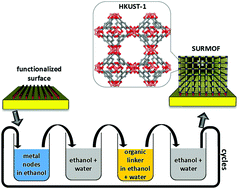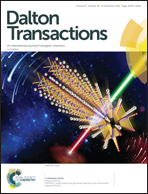Water as a modulator in the synthesis of surface-mounted metal–organic framework films of type HKUST-1†
Abstract
Thin films of nanoporous metal–organic frameworks, MOFs, are widely used for various purposes, ranging from molecular separation to electronic and optical applications. Ultrathin MOF films prepared in a controlled layer-by-layer fashion, also referred to as surface-mounted MOFs or SURMOFs, have attracted particular attention. While many aspects of SURMOF synthesis have been investigated and optimized, the impact of growth modulators, which are well established in bulk MOF synthesis, has so far received only a little attention in the context of layer-by-layer approaches. Here, we investigate the impact of water as a growth modulator during the synthesis of thin MOF films of type HKUST-1. We find that water has a tremendous impact on the crystallinity and on the defect-density of the prepared MOF films. The use of the optimized water concentrations allows considerable improvement in the SURMOF crystallinity and at the same time reduces their defect density. This study shows that water is an important modulator in MOF thin film growth and can be used to tune the material from a low defect to high defect state.



 Please wait while we load your content...
Please wait while we load your content...